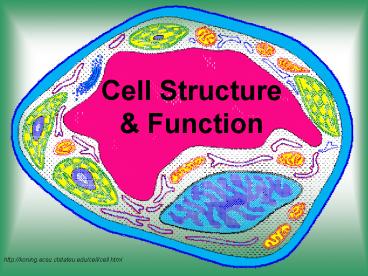Cell Structure - PowerPoint PPT Presentation
1 / 47
Title:
Cell Structure
Description:
Chloroplast. Plasmodesmata. Wall of adjacent cell. Cell wall. Golgi apparatus. Peroxisome ... Chloroplasts. Are found in leaves and other green organs of plants ... – PowerPoint PPT presentation
Number of Views:59
Avg rating:3.0/5.0
Title: Cell Structure
1
Cell Structure Function
http//koning.ecsu.ctstateu.edu/cell/cell.html
2
Cell Theory
- All living things are made up of cells.
- Cells are the smallest working units of all
living things. - All cells come from preexisting cells through
cell division. - Proposed by three German biologists, Matthias
Schleiden, Theodor Schwann, and Rudolf Virchow
3
Definition of Cell
- A cell is the smallest unit that is capable of
performing life functions.
4
Examples of Cells
Amoeba Proteus
Plant Stem
Bacteria
Red Blood Cell
Nerve Cell
5
Two Types of Cells
- Prokaryotic
- Eukaryotic
6
Prokaryotic
- Do not have structures surrounded by membranes
- Few internal structures
- One-celled organisms, Bacteria
http//library.thinkquest.org/C004535/prokaryotic_
cells.html
7
Figure 6.6 A, B
8
Eukaryotic
- Contain organelles surrounded by membranes
- Most living organisms
Plant
Animal
http//library.thinkquest.org/C004535/eukaryotic_c
ells.html
9
Typical Animal Cell
http//web.jjay.cuny.edu/acarpi/NSC/images/cell.g
if
10
- A animal cell
Figure 6.9
11
Typical Plant Cell
http//waynesword.palomar.edu/images/plant3.gif
12
- A plant cell
CYTOSKELETON
In plant cells but not animal cells Chloroplasts
Central vacuole and tonoplast Cell
wall Plasmodesmata
Figure 6.9
13
Cell Parts
- Organelles
14
Surrounding the Cell
15
Cell Membrane
- Outer membrane of cell that controls movement in
and out of the cell - Double layer
http//library.thinkquest.org/12413/structures.htm
l
16
Cell Wall
- Most commonly found in plant cells bacteria
- Supports protects cells
http//library.thinkquest.org/12413/structures.htm
l
17
Inside the Cell
18
Nucleus
- Directs cell activities
- Separated from cytoplasm by nuclear membrane
- Contains genetic material - DNA
19
Nuclear Membrane
- Surrounds nucleus
- Made of two layers
- Openings allow material to enter and leave
nucleus
http//library.thinkquest.org/12413/structures.htm
l
20
- The nuclear envelope
- Encloses the nucleus, separating its contents
from the cytoplasm
Figure 6.10
21
Chromosomes
- In nucleus
- Made of DNA
- Contain instructions for traits characteristics
http//library.thinkquest.org/12413/structures.htm
l
22
Nucleolus
- Inside nucleus
- Contains RNA to build proteins
http//library.thinkquest.org/12413/structures.htm
l
23
Cytoplasm
- Gel-like mixture
- Surrounded by cell membrane
- Contains hereditary material
24
Prokaryotic
- Do not have structures surrounded by membranes
- Few internal structures
- One-celled organisms, Bacteria
http//library.thinkquest.org/C004535/prokaryotic_
cells.html
25
Eukaryotic
- Contain organelles surrounded by membranes
- Most living organisms
Plant
Animal
http//library.thinkquest.org/C004535/eukaryotic_c
ells.html
26
Endoplasmic Reticulum
- Moves materials around in cell
- Smooth type lacks ribosomes
- Rough type (pictured) ribosomes embedded in
surface
http//library.thinkquest.org/12413/structures.htm
l
27
- The ER membrane
- Is continuous with the nuclear envelope
Figure 6.12
28
Ribosomes
- Each cell contains thousands
- Make proteins
- Found on ribosomes floating throughout the cell
http//library.thinkquest.org/12413/structures.htm
l
29
Mitochondria
- Produces energy through chemical reactions
breaking down fats carbohydrates - Controls level of water and other materials in
cell - Recycles and decomposes proteins, fats, and
carbohydrates
http//library.thinkquest.org/12413/structures.htm
l
30
- Mitochondria are enclosed by two membranes
- A smooth outer membrane
- An inner membrane folded into cristae
Figure 6.17
31
Golgi Bodies
- Protein 'packaging plant'
- Move materials within the cell
- Move materials out of the cell
http//library.thinkquest.org/12413/structures.htm
l
32
Golgi apparatus
- Functions of the Golgi apparatus
Figure 6.13
TEM of Golgi apparatus
33
Lysosome
- Digestive 'plant' for proteins, fats, and
carbohydrates - Transports undigested material to cell membrane
for removal - Cell breaks down if lysosome explodes
http//library.thinkquest.org/12413/structures.htm
l
34
- Lysosomes carry out intracellular digestion by
- Phagocytosis
Figure 6.14 A
35
Vacuoles
- Membrane-bound sacs for storage, digestion, and
waste removal - Contains water solution
- Help plants maintain shape
http//library.thinkquest.org/12413/structures.htm
l
36
- Central vacuoles
- Are found in plant cells
- Hold reserves of important organic compounds and
water
Figure 6.15
37
Chloroplast
- Usually found in plant cells
- Contains green chlorophyll
- Where photosynthesis takes place
http//library.thinkquest.org/12413/structures.htm
l
38
- Chloroplasts
- Are found in leaves and other green organs of
plants and in algae
Figure 6.18
39
- Cell structure is correlated to cellular function
Figure 6.1
40
- The cytoskeleton
- Is a network of fibers extending throughout the
cytoplasm
Figure 6.20
41
- Contains a pair of centrioles
42
- Flagella beating pattern
Figure 6.23 A
43
- Ciliary motion
15 µm
44
In Summary
45
There are two major types of cells
- Prokaryotic
- Found in Domains Bacteria and Archaea
- Kingdoms Eubacteria and Archaebacteria
- Eukaryotic
- Found in Domain Eukarya
- Kingdoms
- Protista
- Plantae
- Animalia
- Fungi
46
Major Characteristics
- Prokaryotes
- Small
- Simple cells
- Have cell membrane, cytoplasm, ribosomes, DNA in
form of nucleoid - Sometimes have cell wall, capsule, other
projections from wall (bacterial cilia, pili) - DO NOT HAVE internal organelles or nucleus
47
Major Characteristics
- Eukaryotes
- Larger
- Complex cells
- Have cell membrane, cytoplasm, ribosomes, DNA in
form of chromosomes - Sometimes have cell wall (plants and fungi) and
structures for movement (cilia and flagella) - HAVE internal organelles and nucleus































